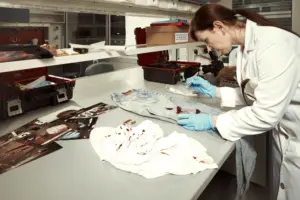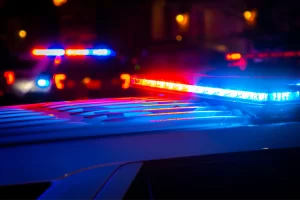Bloodstains at a crime scene hold secrets. To the untrained eye, they’re just messy biological hazards, but for law enforcement, they can be forensic gold. Bloodstain pattern analysis (BPA) blends physics, biology, math, various physical sciences, and investigative skill to piece together violent events. If you’re new to policing or forensics, or simply unfamiliar with how BPA can help you investigate violent scenes, this guide breaks down how to read bloodstains—from drips to mists. Backed by science, it’s your starting point to bloodstain pattern analysis, it’s science, and better resolutions to your cases.
Why Bloodstain Analysis Matters in Forensics
Bloodstain pattern analysis can transform chaos into evidence. It can answer key questions: Where was the victim? How was the attack delivered? Did someone move the body? For beginners in law enforcement, understanding this forensic blood evidence can narrow suspects, challenge alibis, and strengthen courtroom cases. Studies, like those in the Journal of Forensic Sciences, show BPA’s reliability when done right by a properly trained analyst, making it a must-know skill for police.
The Biology of Blood: What You Need to Know
Blood isn’t just a clue—it’s a fluid with unique traits. Made of red and white cells, platelets, and plasma, it’s slightly thicker than water. This viscosity shapes how blood spatters, drips, or splashes when spilled.
How Blood Behaves Outside the Body
When blood exits a wound, it starts clotting. This changes its look over time, a detail officers must note. Research in Forensic Science International shows temperature and humidity affect drying, too. Hot, dry rooms speed it up; cold, damp ones slow it down. For forensic blood evidence, these basics set the stage. They can give you some ideas regarding length of time since the incident, narrowing or expanding the timeline.
Bloodstain Pattern Analysis Science: The Physics Behind the Patterns
Bloodstain analysis hinges largely on physics. When blood flies—whether from a gunshot or a swing of a blood covered bat—it is subject to gravity, velocity, and resistance forces. Here’s how it works for law enforcement.
1. Passive Bloodstains
Gravity pulls blood downward. A drop falling straight onto flat smooth tile forms a generally circular shape. The higher it falls, the bigger the stain—until it hits terminal velocity. Then the shape size does not change much. Measurements can help estimate blood source height.
2. Transfer Bloodstains
A bloody hand swiping a wall leaves a pattern. A bloody shoe walking on hardwood flooring, leaves a pattern. These patterns can help define movements within a scene. This could point toward a suspect fleeing or a prolonged mutual combat, or any number of scenarios. These transfer stains can key in reconstructing crime scenes.
3. Projected Bloodstains
High-force events create unique patterns:
- Arterial breaches: Wave-like stains from a cut artery, pulsing with each heartbeat. Create a characteristic pattern that can provide valuable evidence regarding victim and suspect actions.
- Misting: formerly called “High Velocity Spatter,” are tiny droplets (mostly under 1 mm) that come from high velocity impacts to a blood source. These are often associated with gunshot wounds.
The angle of impact matters, too. An elongated stain means it hit at a certain angle. Breaking out your trigonometry textbook from high school will allow you to determine the angle of impact for the stains. This math, validated by the Journal of Forensic Sciences, can provide blood source location information at or near the time of impact.
Bloodstain Patterns: Decoding the Clues
Bloodstain Pattern Analysis uses patterns to tell the story. The Scientific working Group, Bloodstain Pattern Analysis subcommittee (SWGSTAIN) defines key terms every law enforcement or legal employee should know.
Common Bloodstain Types
- Spatter: Small drops formed as a result of force. The size, shape, and overall distribution can help reveal force action and distance.
- Cast-off: linear or curvilinear patterns from blood being flung off an object in motion. This can help with positioning.
- Void: A blank spot in an otherwise continuously bloody area—something blocked the pattern, possibly a suspect or moved object.
Surface Effects
Rough carpet distorts stains; smooth glass preserves them. The American Journal of Forensic Medicine and Pathology stresses documenting surfaces to avoid errors in bloodstain pattern analysis.
Tools for Analyzing Bloodstains
Police use simple and advanced tools for forensic blood evidence. Rulers measure stains, while stringing traces spatter back to its area of origin. Software like Hemospat and Faro automate angle math, but hands-on skill remains vital. While technology is vital to providing better quality, a skilled analyst is still essential. Picking up tiny clues, verifying the technological outputs, comparing the scene reconstruction to inculpatory and exculpatory evidence are all critical parts of an investigation that technology has not mastered.
Testing and Documentation
- Presumptive Tests: Kastle-Meyer can help determine its blood via hemoglobin identification.
- DNA: can links sampled stains to individuals.
- Photography: Properly taken photographs of stains with scale markers are still superior for analysis and courtroom presentations. They are essential and should not be discounted or overlooked even with the benefits of technology.
Beginners should focus on sketches and photos—your work starts the evidence chain. Often the first photographs and sketches are the most important. They can provide a view of the scene before any possible changes, alterations, drying, or accidental void additions are introduced. Getting it right in the beginning may make or break a case.
How BPA Solves Crimes: A Case Example
Imagine a kitchen scene: blood pools under a body, projection patterns hit the wall, and cast-off patterns paint the ceiling. The pool says the victim bled out there. If there are no alterations to the pool, you can make an assumption the victim did not move much after they fell there. Projection patterns mean a breached artery or vein under high pressure. The autopsy should confirm an injury consistent with this. Cast-off suggests repeated movement of a blood covered object. The potential math could place the attacker in a specific position. A void by the sink hints at a missing object. This science helps build a solid case. Now the investigators are looking for missing items, they have an idea (which would get further clarification after detailed BPA analysis) of what took place. They might have a murder weapon they are looking for. DNA samples can connect suspects (if they bled themselves during a prolonged combat), to the scene and to certain activities. These would not necessarily be available to the investigator without BPA.
Potential Pitfalls in Bloodstain Analysis
BPA isn’t foolproof. Foot traffic can alter stains. Rain dilutes outdoor scenes. Misread angles skew results. The 2009 National Academy of Sciences report notes BPA lacks strict error rates. However, properly trained BPA analysts lower the error rates considerably from this study, which did not limit participants to highly trained analysts. Pairing analysis with DNA or ballistics can also increase accuracy.
Beginners: document everything, assume little, and call experts when unsure.
Why Police Should Learn Bloodstain Analysis
Bloodstain pattern analysis empowers officers. It reveals attack dynamics, exposes lies, and wins convictions. A 2015 Forensic Science Review case showed BPA proving a victim was hit from behind, debunking self-defense claims. For new cops, it’s a skill that turns scenes into solutions.
Ready to dive deeper?
Contact Revelations Training for more information on our BPA I and BPA II class offerings.





